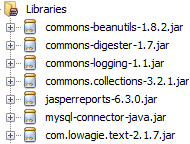Step 1:index.jsp
<%@ page language="java" contentType="text/html; charset=ISO-8859-1"
pageEncoding="ISO-8859-1"%>
<!DOCTYPE html PUBLIC "-//W3C//DTD HTML 4.01 Transitional//EN"
"http://www.w3.org/TR/html4/loose.dtd">
<html>
<head>
<meta http-equiv="Content-Type" content="text/html; charset=ISO-8859-1">
<title>Main Page</title>
</head>
<body>
<a href="view">View Records</a>
</body>
</html>
Step 2: Customer.java
public class Customer {
private int customerId;
private String customerName;
private int forevenId;
public int getCustomerId() {
return customerId;
}
public void setCustomerId(int customerId) {
this.customerId = customerId;
}
public String getCustomerName() {
return customerName;
}
public void setCustomerName(String customerName) {
this.customerName = customerName;
}
public int getForevenId() {
return forevenId;
}
public void setForevenId(int forevenId) {
this.forevenId = forevenId;
}
}
Step 3:Fetch.java
import java.sql.Connection;
import java.sql.DriverManager;
import java.sql.PreparedStatement;
import java.sql.ResultSet;
import java.util.ArrayList;
public class Fetch
{
ArrayList<customer> list=new ArrayList<customer>();
public ArrayList<customer> getList() {
return list;
}
public void setList(ArrayList<customer> list) {
this.list = list;
}
public String execute(){
try{
Class.forName("com.mysql.jdbc.Driver");
Connection con=DriverManager.getConnection("jdbc:mysql://localhost:3306/mapping","root","root");
PreparedStatement ps=con.prepareStatement("select * from customer");
ResultSet rs=ps.executeQuery();
while(rs.next()){
customer user=new customer();
user.setCustid(rs.getInt(1));
user.setCustname(rs.getString(2));
user.setForevenid(rs.getInt(3));
list.add(user);
}
con.close();
}catch(Exception e){e.printStackTrace();}
return "success";
}
}
Step 4:displayrecords.jsp
<%@ page language="java" contentType="text/html; charset=ISO-8859-1"
pageEncoding="ISO-8859-1"%>
<%@ taglib uri="/struts-tags" prefix="s" %>
<!DOCTYPE html PUBLIC "-//W3C//DTD HTML 4.01 Transitional//EN" "http://www.w3.org/TR/html4/loose.dtd">
<html>
<head>
<meta http-equiv="Content-Type" content="text/html; charset=ISO-8859-1">
<title>Login Page</title>
</head>
<body>
<h3>All Records:</h3>
<s:iterator value="list">
<fieldset>
<s:property value="custid"/><br/>
<s:property value="custname"/><br/>
<s:property value="forevenid"/><br/>
</fieldset>
</s:iterator>
</body>
</html>
Step 5:struts.xml
<?xml version="1.0" encoding="UTF-8"?>
<!DOCTYPE struts PUBLIC "-//Apache Software Foundation
//DTD Struts Configuration 2.1//EN"
"http://struts.apache.org/dtds/struts-2.1.dtd">
<struts>
<package name="anbc" extends="struts-default">
<action name="viewrecords" class="Fetch">
<result name="success">displayrecords.jsp</result>
</action>
</package>
</struts>
Step 6: web.xml
<?xml version="1.0" encoding="UTF-8"?>
<web-app xmlns:xsi="http://www.w3.org/2001/XMLSchema-instance" xmlns="http://java.sun.com/xml/ns/javaee" xsi:schemaLocation="http://java.sun.com/xml/ns/javaee http://java.sun.com/xml/ns/javaee/web-app_2_5.xsd" version="2.5">
<display-name>StrutsDemo</display-name>
<display-name>StrutsValidation</display-name>
<filter>
<filter-name>struts2</filter-name>
<filter-class>
org.apache.struts2.dispatcher.filter.StrutsPrepareAndExecuteFilter
</filter-class>
</filter>
<filter-mapping>
<filter-name>struts2</filter-name>
<url-pattern>/*</url-pattern>
</filter-mapping>
</web-app>
Step 7: pom.xml
<project xmlns="http://maven.apache.org/POM/4.0.0" xmlns:xsi="http://www.w3.org/2001/XMLSchema-instance" xsi:schemaLocation="http://maven.apache.org/POM/4.0.0 http://maven.apache.org/xsd/maven-4.0.0.xsd">
<modelVersion>4.0.0</modelVersion>
<groupId>com.my</groupId>
<artifactId>StrutsDemo</artifactId>
<version>0.0.1</version>
<packaging>war</packaging>
<dependencies>
<dependency>
<groupId>org.apache.struts</groupId>
<artifactId>struts2-core</artifactId>
<version>2.5.5</version>
</dependency>
<dependency>
<groupId>mysql</groupId>
<artifactId>mysql-connector-java</artifactId>
<version>5.1.6</version>
</dependency>
</dependencies>
</project>
<%@ page language="java" contentType="text/html; charset=ISO-8859-1"
pageEncoding="ISO-8859-1"%>
<!DOCTYPE html PUBLIC "-//W3C//DTD HTML 4.01 Transitional//EN"
"http://www.w3.org/TR/html4/loose.dtd">
<html>
<head>
<meta http-equiv="Content-Type" content="text/html; charset=ISO-8859-1">
<title>Main Page</title>
</head>
<body>
<a href="view">View Records</a>
</body>
</html>
Step 2: Customer.java
public class Customer {
private int customerId;
private String customerName;
private int forevenId;
public int getCustomerId() {
return customerId;
}
public void setCustomerId(int customerId) {
this.customerId = customerId;
}
public String getCustomerName() {
return customerName;
}
public void setCustomerName(String customerName) {
this.customerName = customerName;
}
public int getForevenId() {
return forevenId;
}
public void setForevenId(int forevenId) {
this.forevenId = forevenId;
}
}
Step 3:Fetch.java
import java.sql.Connection;
import java.sql.DriverManager;
import java.sql.PreparedStatement;
import java.sql.ResultSet;
import java.util.ArrayList;
public class Fetch
{
ArrayList<customer> list=new ArrayList<customer>();
public ArrayList<customer> getList() {
return list;
}
public void setList(ArrayList<customer> list) {
this.list = list;
}
public String execute(){
try{
Class.forName("com.mysql.jdbc.Driver");
Connection con=DriverManager.getConnection("jdbc:mysql://localhost:3306/mapping","root","root");
PreparedStatement ps=con.prepareStatement("select * from customer");
ResultSet rs=ps.executeQuery();
while(rs.next()){
customer user=new customer();
user.setCustid(rs.getInt(1));
user.setCustname(rs.getString(2));
user.setForevenid(rs.getInt(3));
list.add(user);
}
con.close();
}catch(Exception e){e.printStackTrace();}
return "success";
}
}
Step 4:displayrecords.jsp
<%@ page language="java" contentType="text/html; charset=ISO-8859-1"
pageEncoding="ISO-8859-1"%>
<%@ taglib uri="/struts-tags" prefix="s" %>
<!DOCTYPE html PUBLIC "-//W3C//DTD HTML 4.01 Transitional//EN" "http://www.w3.org/TR/html4/loose.dtd">
<html>
<head>
<meta http-equiv="Content-Type" content="text/html; charset=ISO-8859-1">
<title>Login Page</title>
</head>
<body>
<h3>All Records:</h3>
<s:iterator value="list">
<fieldset>
<s:property value="custid"/><br/>
<s:property value="custname"/><br/>
<s:property value="forevenid"/><br/>
</fieldset>
</s:iterator>
</body>
</html>
Step 5:struts.xml
<?xml version="1.0" encoding="UTF-8"?>
<!DOCTYPE struts PUBLIC "-//Apache Software Foundation
//DTD Struts Configuration 2.1//EN"
"http://struts.apache.org/dtds/struts-2.1.dtd">
<struts>
<package name="anbc" extends="struts-default">
<action name="viewrecords" class="Fetch">
<result name="success">displayrecords.jsp</result>
</action>
</package>
</struts>
Step 6: web.xml
<?xml version="1.0" encoding="UTF-8"?>
<web-app xmlns:xsi="http://www.w3.org/2001/XMLSchema-instance" xmlns="http://java.sun.com/xml/ns/javaee" xsi:schemaLocation="http://java.sun.com/xml/ns/javaee http://java.sun.com/xml/ns/javaee/web-app_2_5.xsd" version="2.5">
<display-name>StrutsDemo</display-name>
<display-name>StrutsValidation</display-name>
<filter>
<filter-name>struts2</filter-name>
<filter-class>
org.apache.struts2.dispatcher.filter.StrutsPrepareAndExecuteFilter
</filter-class>
</filter>
<filter-mapping>
<filter-name>struts2</filter-name>
<url-pattern>/*</url-pattern>
</filter-mapping>
</web-app>
Step 7: pom.xml
<project xmlns="http://maven.apache.org/POM/4.0.0" xmlns:xsi="http://www.w3.org/2001/XMLSchema-instance" xsi:schemaLocation="http://maven.apache.org/POM/4.0.0 http://maven.apache.org/xsd/maven-4.0.0.xsd">
<modelVersion>4.0.0</modelVersion>
<groupId>com.my</groupId>
<artifactId>StrutsDemo</artifactId>
<version>0.0.1</version>
<packaging>war</packaging>
<dependencies>
<dependency>
<groupId>org.apache.struts</groupId>
<artifactId>struts2-core</artifactId>
<version>2.5.5</version>
</dependency>
<dependency>
<groupId>mysql</groupId>
<artifactId>mysql-connector-java</artifactId>
<version>5.1.6</version>
</dependency>
</dependencies>
</project>








